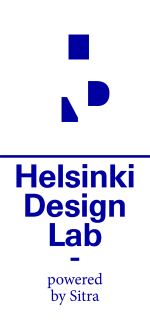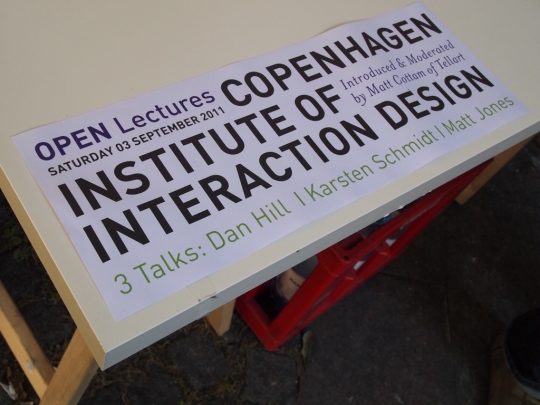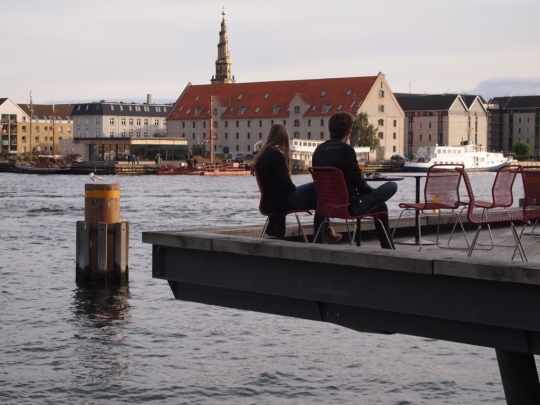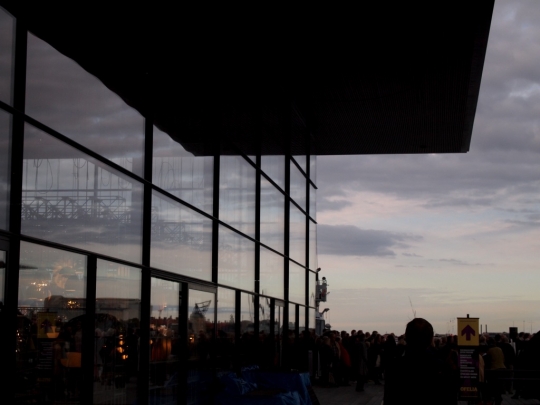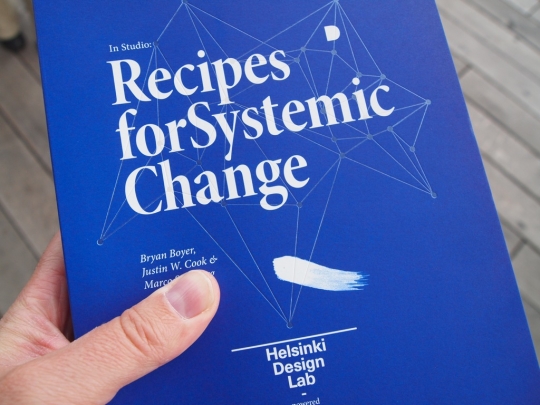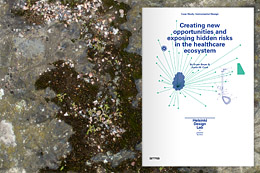Catching up, catching up. As predicted, Autumn is here and the pace is picking up. Several of us are just back from Copenhagen Design Week, where we did a number of productive things, as well as just enjoying that fine city.
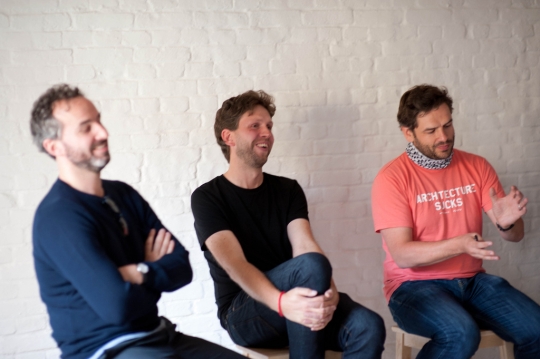
Me, Karsten Schmidt, and Matt Jones, photo courtesy of Matt Cottam.
I was there to speak at the Copenhagen Interaction Design Institute (CIID), with Matt Jones of BERG and Karsten Schmidt of PostSpectacular, organised by the great Matt Cottam (Tellart etc.) and Alie Rose (CIID). The talks from Matt and Karsten were both chock-full of challenging, brilliant thinking and as ever it was a privilege to share the bill with them.
I'll try to post some thoughts from my talk here (or there) later, but essentially it covered the shift from interaction design at the urban scale to strategic design at systemic scale, and the importance of designing both the matter (the objects, spaces, services) at the same time as the meta (the context, the organisation, the culture.)
Low2No is one of our primary examples. Here, what looks like a building project is actually a 'trojan horse' or 'hook' for a whole series of other systemic changes, around the forestry industry, smart cities, food culture, design methods, ownership models, carbon accounting, innovation environments and so on. So this was 'From Matter to Meta' and back again. There's a lot more to come here, but thanks to CIID for organizing and thanks to an attentive crowd, particularly taking the time out from a sunny Saturday afternoon.

Toldboden brunch, photo courtesy of Matt Cottam.
Bryan and I joined Team CIID + BERG for Sunday brunch at Toldboden, which we suspect may be currently the best brunch place in Europe, if not the world. We understand that this is quite a claim, but still.
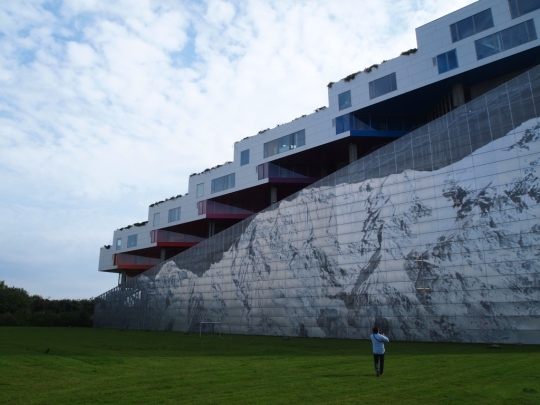
The Mountain, by Bjarke Ingels Group, Ørestad.

VM Buildings, by Bjarke Ingels Group, Ørestad.
Then just time for a quick excursion to Ørestad, to see a couple of fine, and by now well-known buildings by Bjarke Ingels Group (but also the fairly bereft streetscape there. Hmm.)
Bryan and Marco were in town to participate in a conference organised by our good friends MindLab. 'How Public Design? Leading Change in Government' was an international seminar featuring government, academics, design practitioners, and others. The foundations for the conversation were laid down by rich stories and case studies about existing design work within the public sector; the conversation itself often focused on how to scale this work up, and what new cultures of public sector might result, or otherwise be enabled. Thanks also to MindLab for a great event.
As well as general INDEX Award shenanigans (and congrats to one of our collaborators, Alejandro Aravena, for his firm Elemental's award there) we were also in Copenhagen to meet a consignment of The Book (around twelve copies sent to our hotel).
We finally have it in our hands. Called 'In Studio: Recipes for Systemic Change', the content unpacks the studio model and its use in terms of understanding the architecture of systemic challenges and quickly sketching out coherent, practical and imaginative visions that address such interlocking problems. Hopefully you'll find it a useful resource and a good read. Again, credit to Bryan, Justin and Marco for producing a genuinely original contribution, and particularly for Bryan for handling the production. The book looks and feels great, thanks to design by Two Points in Barcelona.There's a foreword by Geoff Mulgan of NESTA, and an afterword by our president, Mikko Kosonen. We'll post about the book separately, very shortly, including details on how to get it.
We've also been working on a dossier around design ethnography; please have a look and let us know what you think. Any comments gratefully received, particularly other references or case studies you think we should link to.
In other work, we've been working hard on Low2No, and I've been picking up two threads in particular: the 'smart systems' work (our informatics-led angles developed by Arup and Experientia) around the building, and then how our organisation develops in the context of the new building. The relationship between building projects and the organisations that inhabit them is complex and symbiotic, and as part of the client body for the block, and ultimately an occupant, we'll be using this opportunity to continue the development of Sitra the organisation too.
In terms of 'smart systems', we're trying to develop a more sophisticated understanding of what this might mean, particularly as compared to yer usual building project. On a typical project, ‘smart systems’ can essentially be seen as shorthand for 'automating everything in sight', which we feel would remove the opportunity for engagement, agency and responsibility from the various users of the building. Which doesn’t feel particularly smart to us.
So we're trying to build up a simpler but more engaged relationship between occupant and other users, building, building technology, organisation, and city. This should take advantage of contemporary thinking around smart systems and smart cities whilst preserving, even expanding, the role of people within and around the building. This is partly to do with our strategic objectives around 'sustainable well-being', and the desire to produce replicable strategies for systemic change, but also to do with creating a simpler, more effective, more enjoyable workplace.
These words might come back to haunt us—until a building is built and occupied, one never knows—but we want the exact opposite of the all-too-familiar hotel room experience in which you're searching for the impenetrable remote control required to turn on the standard lamp. Some things are not problems that need fixing.
Some are, however, and we think we're on to something new and useful with our approaches here. We'll report back on this too, as it develops, on the soon-to-be-relaunched Low2No website. (Yes, I'm aware this is turning into a series of nested links to future posts.)
In the aforementioned CIID talk, around matter and meta, one thing I touched on was redesigning the context around products, services, relationships. Or, as I put it here, "You can't design a transformative service without redesigning the organisation."
This follows the legendary Finnish architect Eliel Saarinen's quote: "Always design a thing by considering it in its next larger context - a chair in a room, a room in a house, a house in an environment, an environment in a city plan." i.e. the context is often an organisation, and so a complex net of relationships, one way or another. As I pointed out in my talk, I think you can go the other way too i.e. design the context considering the thing it is intended to produce. Again, it's symbiotic.
With this in mind, our work in terms of organisational change at Sitra is therefore part of this building project, part of this ICT procurement, and so on. Given that Low2No represents one component in another stage of development for our organisation—a Sitra v4.0 perhaps—we have also been exploring what a Sitra v3.1 or v3.2 might be (this numbering is just an example, as organisations are actually in multiple stages of development simultaneously; it also deliberately avoids using the dread word '2.0'!).
These are small-step experiments that we can do right now, iterations along the way to the new organisation in the new building. These are never binary or direct relationships i.e. the new building does not 'effect' the new organisation into life from day one, nor does a new organisation necessitate or articulate a new spatial context. It's never that simple.
So the .1, .2, .3 series of hops in effect enables the organisation to 'try on' new working methods, relationships, identities, new layouts, patterns and habits. It 'de-risks' the change implied to some extent—it makes a new building three years away into something more tangible and at-hand—whilst enabling the kind of instructive forward momentum that prototypes bring to other fields.
Not that Sitra needs redesigning, but Bryan and I did some work at our recent summer awayday in the beautiful forest around Mikkeli, helping our teams constructively imagine some new working habits, patterns and spaces. We may even be able to prototype some of these in our existing building in Ruoholahti, which helped this become more than just a paper exercise.
Oh, and I've also been writing up our research into food culture in Finland. More on that soon too!
